Biology
It would be hard to believe that zombies develop a taste for human flesh, especially brains, out of nowhere. It would seem that they don?t have a choice; their activities are decided for them. They?ve lost their free will.
It turns out that the movie was based on a 1961 incident near Monterey Bay, California. The birds went nuts and no one knew why ? that makes it creepier. It wasn?t until 1995 when another episode of bizarre behavior in sea lions led to the answer. The sea lions in 1995 and 2010-11 were acting like zombies as well. They wouldn?t get out of the way of boats or they would come up on land and just keep scooting inland until they died.
One such case of co-opted free will in an insect is the Jewel Wasp (Ampulex compressa) and the American Cockroach (Periplaneta americana). The wasp lives in Africa and Asia, so this isn?t something we could use to get rid of NYC cockroaches. P. Americana isn?t even native to the Americas. It was introduced from Africa as early as 1625, before it was officially named.
Why does the wasp turn the cockroach into a zombie? I?m glad you asked. Remember, the cockroach isn?t paralyzed, it just hasn?t the will to walk on its own. So the wasp tugs on the cockroach?s antennae and herds the roach into its underground nest. There the wasp lays an egg in the cockroach?s abdomen and the emerging larva feeds on the cockroach until they are ready to emerge eight days later.
There is a suspicion that T. gondii produces an enzyme that catalyzes the formation of a dopamine precursor. Dopamine is a catecholamine, so it is involved in the fight or flight response; definitely a fear component. The interesting thing is that even a latent (asymptomatic) infection affects men and women differently. Bizarrely, a 2011 study showed that infected men are more attracted to cat urine, while infected women find it less attractive.
House PK, Vyas A, & Sapolsky R (2011). Predator cat odors activate sexual arousal pathways in brains of Toxoplasma gondii infected rats. PloS one, 6 (8) PMID: 21858053
Flegr J, Lenochová P, Hodný Z, & Vondrová M (2011). Fatal attraction phenomenon in humans: cat odour attractiveness increased for toxoplasma-infected men while decreased for infected women. PLoS neglected tropical diseases, 5 (11) PMID: 22087345
Banks CN, & Adams ME (2012). Biogenic amines in the nervous system of the cockroach, Periplaneta americana following envenomation by the jewel wasp, Ampulex compressa. Toxicon : official journal of the International Society on Toxinology, 59 (2), 320-8 PMID: 22085538
Herzner G, Schlecht A, Dollhofer V, Parzefall C, Harrar K, Kreuzer A, Pilsl L, & Ruther J (2013). Larvae of the parasitoid wasp Ampulex compressa sanitize their host, the American cockroach, with a blend of antimicrobials. Proceedings of the National Academy of Sciences of the United States of America, 110 (4), 1369-74 PMID: 23297195
- Cockroach Facts
Cockroaches are considered one of the most successful groups of animals, Because they are so adaptable, cockroaches have adjusted to living with humans much more readily than humans have adjusted to living with them.Cockroaches thrive in nearly every...
- Ant Facts
If a man could run as fast for his size as an ant can, he could run as fast as a racehorse. Ants can lift 20 times their own body weight. With their combined weight greater than the combined weight of all humans, ants are the most numerous...
- The Living Dead - Living Or Dead?
Biology concepts ? characteristics of life, cell theory, reproduction, homeostasis, evolution How could this monster have come from the Walking Dead TV show? In what way is he/she walking, and while she is in dire need of a makeover, can you ...
- Post Of The Living Dead
Biology concepts ? ethnobotany, pathophysiology of diseases, zombies? You know you have a phenomenon when you can knit a zombie. These you can take apart and reassemble, just like real zombies. Knitting a zombie somehow weakens the argument that...
- No Introductions Necessary?
Biology concepts ? introduced species, invasive species, The United States is a melting pot, and it is one of ourgreatest strengths. The questions is, is it also a goodidea for plants and animals?The United States is an amazing place to live; nearly...
Biology
Free Will Ain?t Free
Biology concepts ? neural parasitology, domoic acid toxicity
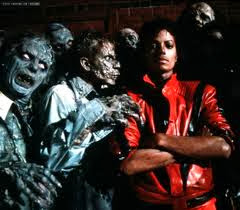 |
| Zombies don?t have a choice in how they behave. Free will is a thing of the past; they don?t even have the ability to resist a dance routine with Michael Jackson. Michael seems awfully at ease in the midst of the undead. Creepy?.yes. Scary?. yes. A thriller??..maybe no. |
Don?t scoff at this; nature is full of examples where one organism can cause another organism to change its behavior ? just think of all the silly things boys do trying to impress girls. But first a couple of stories where a change in behavior has less to do with parasitism.
In August 2013, residents of Moscow began reporting that the pigeons were acting odd. They would walk around in a funk, not get out of the way of traffic, and not fly away from danger. One family reported that their dinner one evening was disrupted by a pigeon on their window ledge that lost its balance and fell into their kitchen.
These zombie pigeons (the pecking dead, as one website called them) were freaking out the population, so the scientists went to work. It seems that many of the dead and affected pigeons were carrying salmonella bacteria and/or had Newcastle disease. The virus that causes this disease, unimaginatively called the Newcastle disease virus (NDV), can be transmitted to humans, so it's a good thing the population got freaked out.
The virus causes the birds to stagger about, stumble around in circles, and turn their heads upside down ? much like vodka does in humans. However, when humans get NDV, they most likely will just have a flu-like episode.
Zombie birds also led to a famous movie. Alfred Hitchcock?s classic film, The Birds, is the story of a terrifying attack on a small fishing village by many flocks of different birds. They attacked people, flew into car windows and houses, and caused deaths and damage. Seems silly doesn?t it, being killed by a shore bird? I think I would have them give some other reason in my obituary.
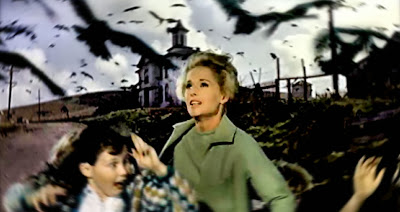 |
| Tippi Hedrin was the female lead in Hitchcock?s The Birds. Hitch had seen her in some commercials and chose her over Grace Kelly?.. GRACE KELLY! Later on , he developed an unhealthy obsession with Tippi, and who wouldn?t, with all that running and screaming and bird doo? |
In 1987, it was recognized that a toxin produced by certain species of marine algae was responsible for the zombie like behaviors. Called domoic acid, the toxin is produced by the algae and accumulates in marine organisms that feed on phytoplankton or algae that are contaminated. Normally, levels of domoic acid are too low to cause problems, but in years where the algae overgrows, called a bloom, the levels will rise dramatically.
Although the acid seems to have no affect on lower life like shellfish, bigger animals are strongly affected, including humans. When the sea lions or birds feed on contaminated food, they begin to display the bizarre behaviors. In the case of the 1961 birds, there happened to be a collection of samples from the bay that had been kept all these years. Tests on the shellfish and algae samples from 1961 showed high levels of domoic acid.
In a strange coincidence, a new paper has been published about how infections can move through a flock of birds. It uses a mathematical model based on many predictors and factors. The model is called the Zombie-City model, based on how a zombie population might grow in a population of unsuspecting humans. But we want to focus on the loss of free will in nature?s creatures.
Free will in lower animals? It does exist. Most people believe that the behaviors of insects and such are merely responses to environmental and situational cues, and any variation in behavior is due to misreading of cues or random errors. But studies in fruitflies show that they can pick out their own patterns of behavior when a blank canvas is given them.
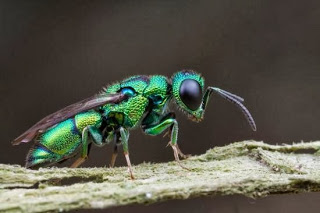 |
| The Emerald Cockroach Wasp (A. compressa) is solitary insect, it doesn?t live communally as many bees and wasps do. Only the females have stingers, so making zombies is definitely a reproductive strategy. In 1941, they were introduced to Hawaii to try and control the cockroach population, but it didn?t work. They just don?t lay enough eggs. |
What the wasp steals is the roach?s ability to decide if it wants to walk or run. Most wasps sting to kill, but the Jewel Wasp stings the cockroach in the brain, altering its behavior with its venom. A 2010 study showed that the wasp stings the roach continuously for up to three minutes, trying to locate a particular part of the cockroach?s brain.
What it is searching for is called the subesophageal ganglion, the part of the brain that allows the roach to initiate walking and running movements. When that part of the brain is flooded with venom, the cockroach stands still, with no will to begin leg movements. It isn?t paralyzed ? it?s just a zombie.
Another study has started to investigate just how the wasp venom robs the cockroach of its will to walk. There is an insect neurotransmitter called octopamine that is released by some of P. Americana?s neurons. It is this transmitter that allows the cockroach to initiate walking.
The study hasn?t pinpointed just how the venom interrupts the octopamine signaling, but they know if they deplete the amines in the brain, they see the same affect. If they add back octopamine, they can rescue the cockroach?s natural behavior. However, the study also showed that the venom doesn?t reduce octopamine levels and it doesn?t prevent is release, so there's still more work to be done.
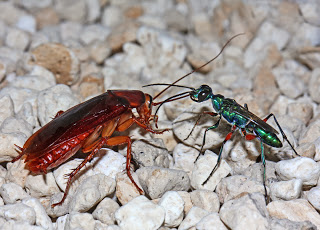 |
| The wasp first stings the cockroach in the abdomen, just a quick sting to temporarily weaken the front legs. Then it stings the brain and when the cockroach stops moving, it cuts off part of one antenna. I don?t know why. It grasps the antenna in its jaws and herds to the roach to its nest. Instead of pulling, they should evolve saddles. |
So why not just kill the cockroach with the sting and lay the egg? The larva need fresh meat, and a dead cockroach rots in one day. To make the meal satisfactory for the eight days needed, the cockroach must remain alive, but in a state where it can?t attack the wasp or the larva; hence the zombification.
It gets even creepier. The wasps have gotten so good at this strategy that they now go to the trouble of cleaning their meal. A 2013 study shows that the wasp larvae produces several antimicrobial chemicals that rid the cockroach of any contaminating bacteria or parasites as the larvae munch on it. I know I?d clean a zombie before I ate it.
There are several other examples of theft of free will, including a couple of fungi that make ants stop their normal work and climb high in trees to allow for the best spread of the fungal spores as they mature. There?s also a hairworm that forces grasshoppers to commit suicide by jumping into water, just so the worm can complete its life cycle. But I don?t want to leave this subject without hitting the king of neural parasitology ? Toxoplasma gondii.
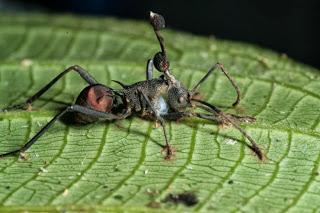 |
| The spiny ant is the zombie victim of the O. unilateralis fungus. When infected, the ant stops doing its job for the colony and falls out of the tree canopy. After wandering the forest floor, it will bite the underside of a leaf and never let go. It just stays there waiting to die. Then the fungus sprouts a fruiting body with spores out the top of its head, and the spores shoot of into the air. The low altitude (less humid) and under leaf position give the fungus the greatest chance to survive. Fossil evidence shows that this has been occurring for at least 48 million years. |
T. gondii is a single-celled eukaryotic parasite that has a complex life cycle. It can reproduce asexual in any of the hosts it infects, but can only reproduce sexually in cats, of all things. This is important because sexual reproduction is an obligate life cycle stage for the parasite and contributes to its evolutionary health.
The parasite has taken steps to insure that it finds its way into cats by changing the behaviors of the mice and rats it finds itself inside. It messes with rodent brain chemistry (since it tends to form cyst organisms in the brain) that makes rodents unafraid of cats. In fact, a recent study found that the organism confuses the rodents into believing that cat urine smells like a potential mate!
T. gondiiactivates a certain neuronal transcription factor, which leads to increased production of different proteins in the brain. In rodents and humans, this leads to an increase in dopamine (similar to octopamine in the cockroach) production and a decrease in tryptophan usage.
Because the cysts target areas of the rodent brain that control fear, the change in behaviors are involve, but are not limited to fear. There isn?t any evidence that the cysts have a selective range in the human brain, but considering the changes that occur in men as described below, it is a possibility.
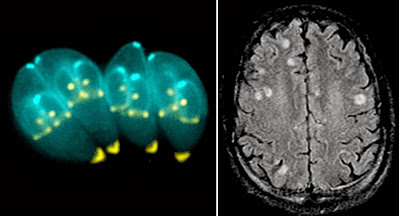 |
| On the left are four T. gondii parasites and on the right are the cysts that they can form in the brain. Recent ecvidences are showing that cysts of T. gondii can be linked to increased chance of suicide attempt and more violent attempts, more depression and neurotic behavior, and an increased chance of having children that will develop schizophrenia. In humans, this may have something to do directly with the parasite, or it may be that high levels of immune modulators lead to the changes in thoughts and behaviors. Scary thought, our immune system could drive us to kill ourselves. |
In general, men with a long-term T. gondii infection show lower IQs, are taller (about 3 cm on average), and are more likely to break rules, take risks, be jealous, and exhibit anti-social behaviors. Right now ? I?m not so proud to be a guy.
On the other hand, women with long-term toxoplasmosis infections tend to be more outgoing, friendlier, more promiscuous, and more attractive to men. Wow, Mars and Venus to the nth degree! The question still remains ? how do the forced behavior changes in humans benefit the organism?
Next week, we return to our discussion of nucleic acid exceptions by discussing instances where organisms can rewrite their genetic code.
For more information or classroom activities, see:
Moscow zombie pigeons-
http://www.kpopstarz.com/articles/38494/20130821/zombie-pigeon-russia-moscow-pecking-dead.htm
http://www.rferl.org/content/russia-moscow-zombie-pigeons-deaths/25075473.html
http://www.huffingtonpost.com/2013/08/21/zombie-pigeon-moscow-salmonella_n_3787503.html
http://rt.com/news/dead-pigeons-dangerous-moscow-615/
http://www.birdtrader.co.uk/news/growing-worries-about-zombie-birds-in-the-city-of-/1218
Domoic acid toxicity ?
http://www.marinemammalcenter.org/science/top-research-projects/domoic-acid-toxicity.html
http://www.oceansoffun.org/index.php/146
http://www.google.com/url?sa=t&rct=j&q=&esrc=s&source=web&cd=13&ved=0CHQQFjAM&url=http%3A%2F%2Fic.ucsc.edu%2F~kudela%2FOS130%2FReadings%2FDA_review.pdf&ei=rE5PUvSrAeKYyAHq_oGIAQ&usg=AFQjCNHsN2VhTwLa8CBCaPlHL39HfFxzqw&sig2=YdOw2vBxBSQaChe9KETiAA&bvm=bv.53537100,d.aWc
http://www.sciencedaily.com/releases/2008/06/080609103232.htm
http://www.thepoisonreview.com/2011/12/30/angry-birds-or-domoic-acid-toxicity/
http://www.nature.com/ngeo/journal/v5/n1/full/ngeo1360.html
http://w.bird-rescue.org/pelican_domoic.html
http://www.independent.co.uk/arts-entertainment/films/news/mystery-behind-hitchcocks-birds-is-solved-at-last-6282470.html
Jewel wasp and cockroach ?
http://news.nationalgeographic.com/news/2007/12/071206-roach-zombie.html
http://ed.ted.com/lessons/parasite-tales-the-jewel-wasp-s-zombie-slave-carl-zimmer
http://www.odditycentral.com/animals/insect-body-snatchers-how-the-jewel-wasp-turns-cockroaches-into-zombies.html
http://www.examiner.com/article/the-emerald-jewel-wasp-amazing-killer-predator-of-the-american-cochroach
http://blogs.scientificamerican.com/science-sushi/2013/01/07/parasitic-wasps-master-microbiology-on-addition-to-neurochemistry/
Toxoplasma gondii ?
http://www.livescience.com/21345-t-gondii-parasite-suicide-attempts.html
http://www.theatlantic.com/magazine/archive/2012/03/how-your-cat-is-making-you-crazy/308873/
http://blogs.discovermagazine.com/bodyhorrors/2011/04/28/consider-the-carpaccio-looking-at-toxoplasmosis/#.Uk9apIVf13I
http://www.stanleyresearch.org/dnn/Default.aspx?tabid=204
http://www.cnn.com/HEALTH/library/toxoplasmosis/DS00510.html
http://www.mayoclinic.com/health/toxoplasmosis/DS00510
http://www.medicalnewstoday.com/articles/247346.php
http://www.healio.com/infectious-disease/stds/news/print/infectious-disease-news/%7B758ef041-1b0d-40c3-9351-4613866ebfb3%7D/new-risk-factor-identified-for-toxoplasma-gondii-infection
http://lesswrong.com/lw/8gz/is_latent_toxoplasmosis_worth_doing_something/
http://joannenova.com.au/2012/02/toxoplasmosis-could-that-latent-infection-affect-peoples-behavior/
http://www.babycenter.com/0_toxoplasmosis-during-pregnancy_1461.bc
Fungal parasites and ants ?
http://www.wired.com/wiredscience/2013/09/absurd-creature-of-the-week-zombie-ant-fungus/
http://news.nationalgeographic.com/news/2012/05/120504-zombie-ant-fungus-science-environment-rainforest/
http://www.scientificamerican.com/article.cfm?id=zombie-ant-fungus-parasite
http://www.youtube.com/watch?v=-_1FjXb8T1Y
http://news.psu.edu/story/277383/2013/05/21/research/getting-bottom-zombie-ant-phenomenon
http://whyevolutionistrue.wordpress.com/2012/07/18/zombie-ants-controlled-by-fungi-and-worms/
http://www.livescience.com/20099-ant-zombie-mind-controlling-fungus.html
http://www.dailymail.co.uk/sciencetech/article-1386717/Why-zombie-ants-infected-mind-controlling-fungus-kill-high-noon.html
http://news.discovery.com/animals/endangered-species/zombie-ants-fungus-amazon-110303.htm
Hairworm and grasshopper -
http://news.nationalgeographic.com/news/2005/09/0901_050901_wormparasite.html
http://www.nytimes.com/2005/09/06/science/06hopp.html?_r=0
http://rspb.royalsocietypublishing.org/content/272/1577/2117.short
http://www.ext.colostate.edu/pubs/insect/05610.html
http://www.loe.org/shows/segments.html?programID=05-P13-00040&segmentID=6
http://www.sciencebuzz.org/blog/hairworm-observed-emerging-mantis
Zombie apocalypse case study for class -
http://sciencecases.lib.buffalo.edu/cs/collection/detail.asp?case_id=654&id=654
- Cockroach Facts
Cockroaches are considered one of the most successful groups of animals, Because they are so adaptable, cockroaches have adjusted to living with humans much more readily than humans have adjusted to living with them.Cockroaches thrive in nearly every...
- Ant Facts
If a man could run as fast for his size as an ant can, he could run as fast as a racehorse. Ants can lift 20 times their own body weight. With their combined weight greater than the combined weight of all humans, ants are the most numerous...
- The Living Dead - Living Or Dead?
Biology concepts ? characteristics of life, cell theory, reproduction, homeostasis, evolution How could this monster have come from the Walking Dead TV show? In what way is he/she walking, and while she is in dire need of a makeover, can you ...
- Post Of The Living Dead
Biology concepts ? ethnobotany, pathophysiology of diseases, zombies? You know you have a phenomenon when you can knit a zombie. These you can take apart and reassemble, just like real zombies. Knitting a zombie somehow weakens the argument that...
- No Introductions Necessary?
Biology concepts ? introduced species, invasive species, The United States is a melting pot, and it is one of ourgreatest strengths. The questions is, is it also a goodidea for plants and animals?The United States is an amazing place to live; nearly...
